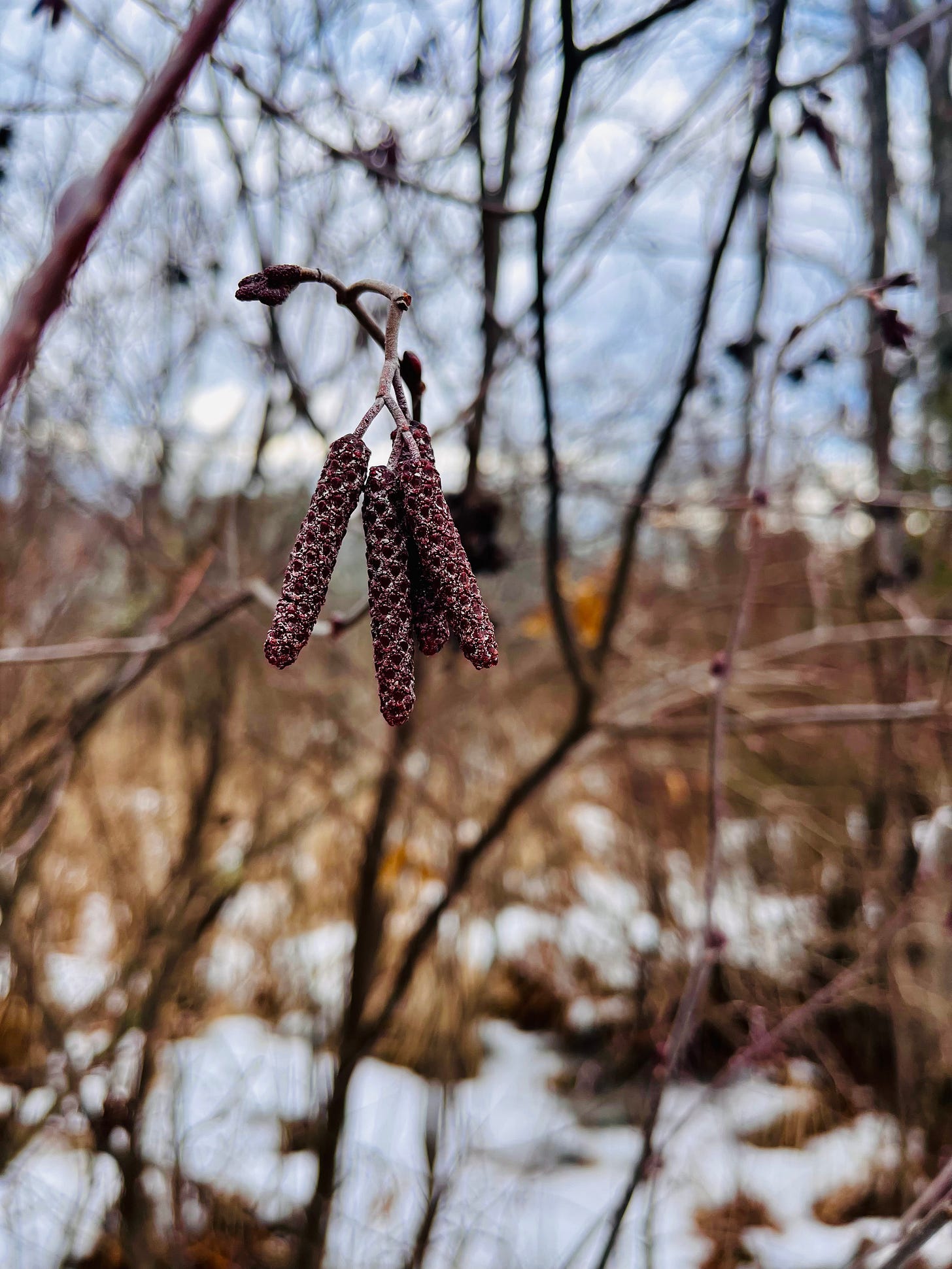If it weren’t so damn windy all the time, I would describe March as the month that holds its breath. April, which Eliot called the cruelest month, gets its cruelty in that great poet’s mind from the very things that make most of us love it: the mild weather, the flowers, the annual miracle of shoots and leaves and returning to the fields and boughs. Like its dark twin October, April is a month of transformation here in New England. By the end of it, the world will look and feel utterly different.
In the meantime, though, we have March. The month of cold hints. The long thaw. Most years, that thaw is figurative and psychological. This year, it looks like it will be literal. Though daytime highs have occasionally snuck up meekly into the fifties, the nights are still freezing hard, leaving the snow—now compacted to ice—clinging obstinately to the ground in every patch of shade. On a hike with my boys the other day, we took a moment to stand and listen to the red-winged blackbirds, recently returned from their winter sojourn in the southern U.S., singing in the trees. Their fluted song mingled with the runneling snowmelt at our feet—you could hear the whole land and sky shifting, almost imperceptibly but inevitably nonetheless, towards spring. The air was cold and fresh, hazel catkins clung to the empty branches. But, just as we were getting in the car to head home, I saw green: the smallest blade-edge of a snowdrop pushing through the muddy earth near the parking lot.
March isn’t as busy as April, but there’s still plenty to do to prepare the garden for the season to come:
1/ Cut Back Woody Herbs
Lots of herbs are perennial even this far north (Zone 6b), including thyme, sage, oregano, and even some species of rosemary. In the Veggie Garden at CCA, we actually retained flavorful tyme throughout the winter—a miracle of microclimates. But even though it’s tempting to leave those struggling bits of green where they lay, you have to be merciless. March is the moment to hack sage, rosemary, oregano, and thyme back very hard, letting the gathering air and light back down into the base of the plant and stimulating fresh new growth. I tend to take thyme and sage right to the ground—oregano as well—and to reduce rosemary by at least thirty percent. It feels sad to cut off your chances, literally and figuratively, of enjoying any fresh herbs for the rest of the month, but the flush of fragrant new growth later in the spring will be worth it.
2/ Cut Back Group Three Clematis
I’m obsessed with clematis—I grow at least five different varieties in my home garden. They come in three different groups, delineated by their bloom time. Clematis “montana,” a famous early-blooming Group One, is one of the first flashes of vividness at the end of our driveway. Clematis “Niobe,” a Group Two, will bloom twice if properly cared for. But I tend to favor Group Three clematises, such as “Jackmanii” and, best of all, Clematis “purpurea plena elegans” with its froth of papery purple double-blooms. Each variety needs to be cared for slightly differently but, for the Group Threes, it’s now time to cut any vines still clinging to fences or trellises right down to the ground. If you neglect to do so, the flowers will tend to bloom only at the top, ruining the effect. Plus it’s a thrill to watch them do their annual magic trick again, climbing from the leafy earth up, up, up, until the moody fireworks begin again in June.
3/ Clean and Rake Out Garden Beds
If you followed my advice last fall, you’ll have chopped off any vegetable plants in your beds above the root and left them to rot over winter, roughly hoeing up the earth around them and letting time and weather work the fallow soil. All that does wonders for the biome of your growing space, allowing nitrogen trapped by falling snow, and other nutrients carried by cascading rain, to penetrate the earth. But now it’s time to reestablish order, pulling out and composting or burning those old roots and raking the beds into a lovely, loamy, even tilth—the workable texture that makes a good veggie garden so nice to spend time with. Use a leaf rake to get out the larger debris, then switch to a metal rake to even the surface into a zen-garden uniformity. The goal is that you should be able to plant seedlings with nothing but your hands, and that means a soft, open soil structure.
4/ Enjoy What’s Already Blooming
The Witch Hazel in my home garden (Hamamelis “Diane”) is in full bloom at the moment, brightening an otherwise flinty green-gray landscape with its red-orange streamers of flower. If you don’t have winter bloomers in your garden, consider installing some hazel, snowdrops, or winter crocuses for next year. Extending the bloom season in that way pays enormous dividends to the soul during a bleak stretch of the calendar. And, in the meantime, take a trip to a local arboretum or sanctuary and see of you can catch the hazels or snowdrops in bloom. You’ll probably have the place to yourself, and the spectacle will get you ready for spring.









